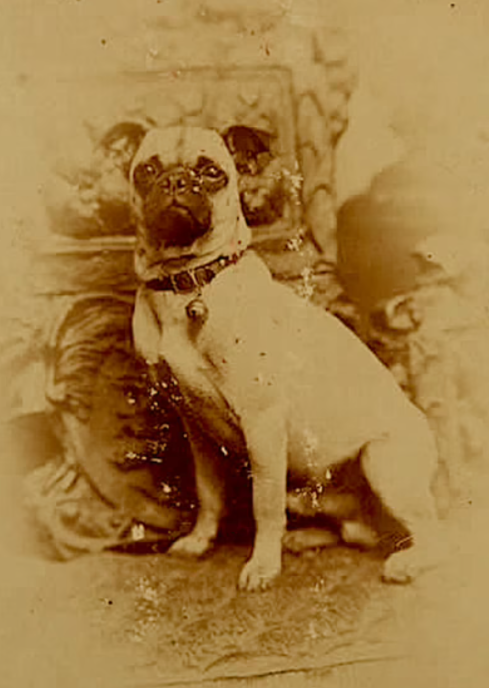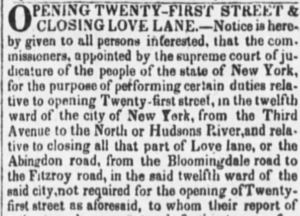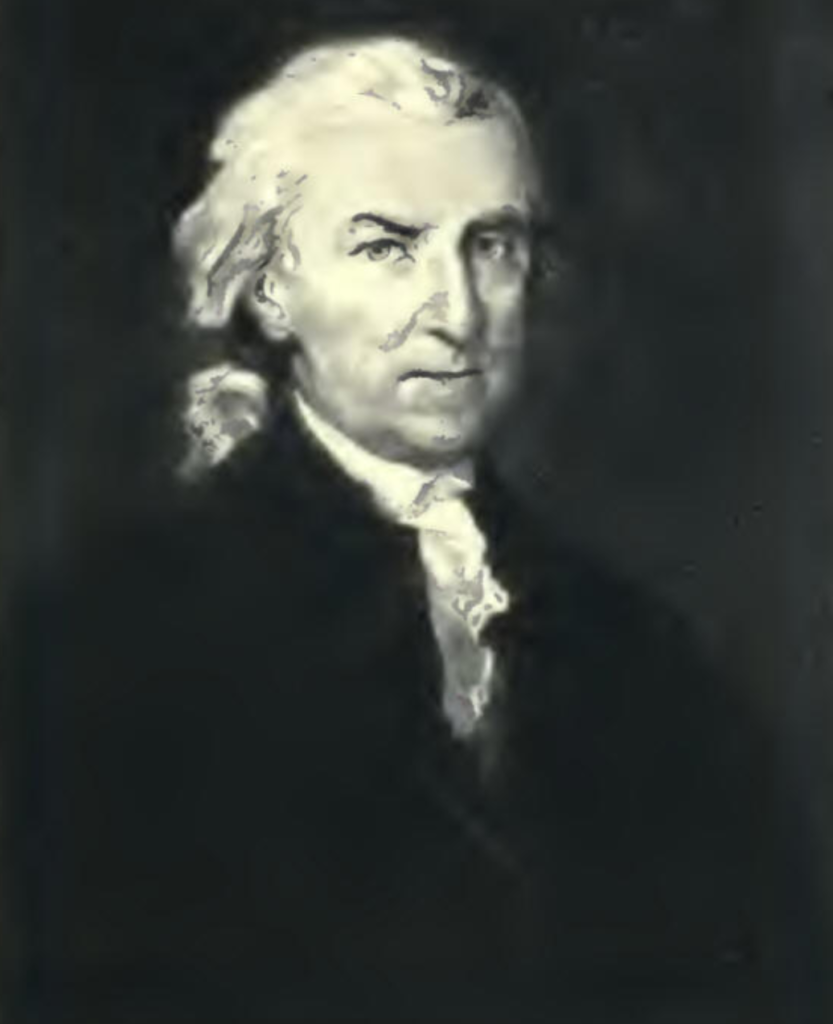
The following story took place on East 21st Street, which was once the southern boundary of the eighteenth-century Rose Hill Farm.
As this festive holiday tale was reported in The Sun on December 29, 1893, “There was much ado on Christmas Eve in the home of Mrs. Brewer, at 43 East 21st Street, and no trouble was spared in decking the towering Christmas tree, to the illumination of which on Christmas night Mrs. Brewer had invited her friends.”
Apparently, the invitations did not mention in whose honor the preparations were made for the grand party that was to take place in the four-story boarding house. So naturally, there was “great astonishment” when word leaked out that the honoree was a dog. An aristocratic dog, “well fed and plump,” to be more exact.
When the female guests arrived at the party and had assembled themselves around the tree, Puck walked into the room on his hind legs beside his mistress. He had a napkin tied around his neck.
Next to the tree was a child-size chair. Puck jumped onto the chair and watched with interest as Mrs. Anna Brewer lit the candles on the tree. When all the candles were lit, the little pug began to bark while the guests clapped their hands.
As the New York Evening World noted, “He barked his delight…and worked his Schneiderian membrane so hard sniffing at the sweets that he almost had convulsions of his uvular process.”

“He wants some candy,” Mrs. Brewer said as she began pulling at some candies that she had hung on the tree. Puck caught the candies in his mouth, jumped off the chair, walked on his hind legs to a table, and helped himself to all the other delicacies that his mistress had set out for him. According to the Evening World, “he fairly wallowed in caramels and marshmallows” while the guests nearly smothered the dog with kisses.
When Puck tired of feasting on the treats, Mrs. Brewer removed his napkin. At last, the human guests were allowed to partake in the food and festivities.
A few days after the party, the Evening World wrote a snarky review of the affair:
“Has your pug dog seen Santa Claus this year? Has the dear little smudge-nosed darling had its Christmas gift? No? Ah! What a pity! What a shame! Don’t let the poor, precious pet see these remarks, then, and don’t tell it anything about that pampered pug Puck on East Twenty-first Street, who has had a Christmas tree all to himself…
There are dogs and dogs just as there are babies and babies, and we are sure there are some dogs in this town just as there are some babies in this town that did not have Christmas trees of their own. How sorry we all ought to be for those Christmas-treeless dogs who have never met Santa Claus or wore a napkin around their necks at a Yule banquet of bonbons or even felt the ultimate differentiated thrill of joy which a flea on the end of Puck’s tail must have been shaken with Christmas Eve.”
Now, perhaps Mrs. Brewer was simply rewarding her pug for stopping a burglar who had broken into her home eight months earlier.
According to the Albany Morning Express, a four-foot-tall man named George Oppinger was found in her house on the night of April 4,1893. Authorities had been on the alert for the man, after receiving a cable from Scotland Yard that he was sailing from England to New York to escape charges. He was arrested and sentenced to six years in state prison.
The article doesn’t mention anything about Puck, but perhaps the small dog alerted Mrs. Brewer to the small criminal.
Tootsie the Pug Responds

Apparently, the Evening World’s sarcasm was lost on at least one pug-adoring woman.
On January 13, 1894, the Evening World published a letter from Ida L. Follett of Dayton, Ohio, that that she had addressed to Mrs. Brewer. In the letter, Mrs. Follett wrote:
“I didn’t think any one was as foolish(?) over a dog as I am, for I also had a tree for my Tootsie. The article pleased me so.” Mrs. Follett went on to write that her pug was six years old, and that she had bottle-fed Tootsie since she was a baby (as the mother dog had such a large litter and could not feed them all).
Like Puck, Tootsie was a spoiled dog. For Christmas that year, she received an ottoman, a combination bank, a session with a professional photographer, some toys, and some pennies for the bank.
Tootsie at least shared some of her wealth: she reportedly saved her pennies each year until February 4, when Mrs. Follett would buy flowers for the grave of her sister, who had loved the little dog just as much as she did. (Maybe Mrs. Brewer got some noble ideas after reading this letter.)
Love Lane and the Rose Hill Farm
If you enjoy New York City history, the following is a detailed history of Love Lane and Rose Hill Farm, in what is now the Rose Hill neighborhood, just north of Gramercy Park and west of Kips Bay.
Prior to 1827, a private lane called the Abingdon Road, aka Love Lane, ran on or near the line of 21st Street. On the east side, Love Lane extended to today’s Park Avenue South, then angled northeast to Third Avenue and East 23rd Street. On the west side, it extended to the Fitzroy Road (Eighth Avenue).

According to Charles Hemstreet, author of Nooks and Corners of Old New York (1899), the lane originally took its name from the oldest daughter of Admiral Sir Peter Warren, who married the Earl of Abingdon (the lane was the northern limit of Warren’s 300-acre estate). The name Love Lane was established in the late 18th century.
Hemstreet theorized that Love Lane became a nickname for the Abingdon Road because it was a favorite road for dating couples to take long carriage rides out to the country (which is what midtown Manhattan was then called). “The generally accepted idea is that being a quiet and little traveled spot, it was looked upon as a lane where happy couples might drive, far from the city, and amid green fields and stately trees confide the story of their loves.”
The old lovers’ lane began to disappear in 1827, when 21st Street was ordered opened. In 1899, six years after this story of Puck the pug took place, there were still five old houses on West 21st Street that had once existed on Love Lane: 25, 27, 51, 53, and 55 (the latter three were thought to have been a single large house serving as a tavern).

Another small private road–Rose Hill Street–which ran on a northwest angle from Love Lane to the Eastern Post Road, traversed the land on which Puck and Anna Brewer’s apartment building at 43 East 21st Street was constructed in the mid-1800s. This street was named for the Rose Hill Farm, a large farm and country estate owned by the Honorable John Watts.

John Watts, the son of Robert and Mary Watts, was born in New York on April 5, 1715. Following his education abroad, he returned to New York to become one of the most eminent lawyers in the country.
Among his many accomplishments, Watts was a member of the New York State Assembly, he founded the New York Society Library, and he was the first president of the New York City Hospital (now the Weill Cornell Medical Center), which he also helped in organizing.

On November 13, 1747, five years after his marriage to Anne de Lancey, Watts obtained about 130 acres of land bounded by the Bloomingdale Road (Broadway), Eastern Post Road, and Love Lane. The farm was called the Rose Hill Farm, named for the Watts family’s ancestral estate in Scotland.
John Watts purchased the property—originally part of the Stuyvessant farm—from his brother-in-law, Lieutenant-Governor James de Lancey. He built a mansion on a hill just north and west of East 24th Street and Second Avenue, where he and Anne lived with their many children during summer months (Rose Hill was their country retreat; the Watts family also had a “city” home at 3 Broadway, facing Bowling Green.)
A long roadway lined with elm trees and flanked by fields and woodland extended southeasterly toward the Rose Hill mansion from the Eastern Post Road and present-day East 28th Street.
Rose Hill was the favorite resort of the aristocracy during this time, as John and Anne were well connected with New York City’s leading families and held an important place in society.

The Final Years of Rose Hill Farm
Alas, Watts’ loyalty to the King of England forced him and Anne to leave New York and flee to Wales in 1776 near the start of the Revolutionary War. Anne died a few months later, and John never returned to America.
The family’s large estate, including Rose Hill and the house on Broadway, was confiscated by the Committee of Forfeiture. After the war ended, his oldest sons, Robert and John, unsuccessfully petitioned to reclaim their properties. They were eventually allowed to buy back the properties in 1784, which included vast holdings in ships, mills, factories, banks, and investment houses.
In 1786, John Watts Jr. sold a large chunk of the property to Nicholas Cruger, then one of the most prominent merchants in New York City (and a mentor of a young Alexander Hamilton). Watts retained the southwestern portion of the farm as his country estate.
The main house at Rose Hill had burned down in 1779 during the British occupation. Cruger rebuilt the estate house and all the farm buildings destroyed during the Revolution. Then in February 1790, he advertised that Rose Hill Farm was for sale.

The lengthy ad that appeared in the New-York Daily Advertiser gives a full picture of Rose HIll at this point in time:
A Farm for Sale. That very elegant and pleasantly situated FARM, Rose Hill, lying on the banks of and adjoining the east river, three miles from this city, containing 92 acres of valuable land, in the highest cultivation, chiefly in mowing ground, the whole well inclosed, principally with stone fences of a superior construction, bounding on the public road 1175 feet; a pleasant avenue through the orchard in front of the house, also a good road that comes out into the bowery land, next to the honorable James Duane’s; on the premises there is an elegant dwelling house of 50 by 37 feet; a commodious farm house of 50 by 20 feet; an excellent barn with carriage houses and stable, 20 by 40 feet, a hovel with a large hay loft over the whole 96 by 15 feet, corn crib, fowl house &c. all the buildings are new and well finished in the most commodious manner, a fine bearing orchard of 260 engrafted apple trees of the most approved sorts, and a great variety of other kinds of the best English and American fruits, a thriving nursery of upwards of 9000 young fruit trees, numbers of which are inoculated and engrafted; an elegant garden, with the finest collection of flowers, flowering shrubs, strawberry, asparagus beds, etc. ten acres in wheat and rye.
Cruger did not end up selling the land; he instead leased the property to General Horatio Gates–ironically, a Revolutionary War hero–in September 1790. General Gates established his country seat at Rose Hill, which, in addition to the large, two-story frame and brick estate house, included barns, outhouses, and fruit and vegetable gardens. He and his wife, Mary, kept only the area around the manor house for themselves, renting out most of the surrounding farmland.

General and Mrs. Gates received many prominent visitors at Rose Hill, including Thomas Paine and General Tadeusz Kosciuszko, a. Polish military engineer who served in the Revolution and designed American forts such as West Point.
The General passed away in April 1806, but Mary Gates continued to live at Rose Hill until her death in 1810. The home was then leased to Gamaliel Smith, a merchant who established his summer retreat there from 1811 to 1815.
Eliza Leaycraft Smith, the young daughter of Gamaliel Smith, described Rose Hills as follows:
“…a beautiful place on the east river, about 24th St. Two blocks below Bellevue hospital, which was commenced while we lived there. This place was only three miles from the Battery, and you would have supposed you were at least thirty miles from the city. The house was large and handsome, standing on a hill with a gentle slope to the farm house, [a] nice large building, with several barns; beyond the lawn was very expansive with numbers of splendid trees...A carriage road of white pebbles surrounded the house, & a beautiful grove of cedars led to the garden which was filled with every variety of the best and choicest fruit.“
In 1812, the Rose Hill property was surveyed and partitioned into 1,010 individual lots to be divided among the heirs of Nicholas Cruger, which included his second wife, Ann Rogers, and his eight children.
Following this event, one of the first major developments occurred in 1826 when an association of New York butchers purchased lots along 24th Street, just west of Third Avenue, for the establishment of a cattle market and tavern known as the Bull’s Head Tavern (the tavern was destroyed by fire in 1841).

Most of the area around Rose Hill Farm, however, retained much of its rural, undeveloped character during the 1820s and 1830s, as noted in the 1827 map above.
By 1830, the old Rose Hill mansion had been converted to a boarding house, as advertised in the Evening World in the summer of 1830. The home was still standing until at least 1835 (the “large and substantial” mansion was advertised for sale in April 1835), and the barn reportedly remained on 24th Street for a bit longer.
As for the four-story boarding house at 43 East 21st Street where Puck and Mrs. Brewer lived, that building was demolished and replaced with a four-story brick parking garage (41-47 East 21st Street) in 1955. The building is currently being converted to a self-storage facility due to an uptick demand for self-storage as a result of Covid-19.

T




yes, foolish. It used to mean fond, ands both meant lovign ot the poitn of foolishness.